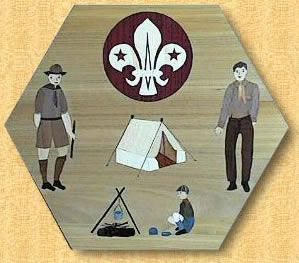|
 |
|
![]()
34 - THE STAFFORDSHIRE CANALS Without the canals to move heavy fuel, raw material and finished products, the Potteries could never have developed in Staffordshire. Nowadays, however, the county's waterways are principally used for leisure. The map shows the main waterways including the Trent and Mersey and Shropshire Union canals. Staffordshire Group |
 |
 |
35 - THE STAFFORDSHIRE POTTERIES The elements are a plate from the factory of Josiah Spode, a potter working at his wheel, a typical "Bottle Kiln" and a statue of the other famous Josiah - Wedgwood. Also included are a "Stafford Knot" - a symbol widely used throughout the county, and a map of Staffordshire with kilns marking Stoke-on-Trent. Staffordshire Group |
36 - HARROW 1840 This marquetry picture was taken from a painting by H Hooker dated 1992. It is a study of Harrow-on-the-Hill, circa 1840, and depicts the famous "Harrow School" on the right hand side and St. Mary's Church centrally. The painting was presented to the wife of one of the Harrow Group members. Harrow Group |
 |
 |
37 - HARPENDEN CREST Harpenden, a small Hertfordshire town (Known locally as the 'Village'), retains much of its rural origins depicted on the tile. The towns Crest is surrounded by pictures representing activities or events: horse racing on the common (now ceased), the many public houses (The Cross Keys is over 250 years old) and the two breweries that serviced them (Now drunk dry!), the strong link with agriculture and the Rothamsted Experimental Station, and the advent of the railway with the engineering feat of the Skew bridge. Harpenden |
38 - MOTHER THERESA Born Agnes Gonxha Bojaxhiu, in Skopje, Macedonia, Mother Theresa was a Catholic Nun. In 1948 she became an Indian citizen and founded the Missionaries of Charity based in Calcutta that helps abandoned children and the dying. More than 4000 nuns staffed the orphanages, Aids Hospices, mental homes and basic medical clinics alongside numerous volunteers. She was awarded the Nobel Peace Prize in 1979. Indep. - E Turner |
 |
 |
39 - THAMES FLOOD BARRIER Giant roofs covered with stainless steel house the mighty machinery needed to raise the ten massive gates from the river bed. London's flood protection, necessary because the sea level off south east England is rising, is 580 yards long, cost £535 million and was first used in 1983. Bexley - Al Malah |
40 - QUEEN ELIZABETH, THE QUEEN MOTHER Her Majesty Queen Elizabeth, the Queen Mother is the mother of Queen Elizabeth II, the present British Sovereign, and the widow of the late King George VI. Born on August 4th 1900, the Honourable Elizabeth Angela Marguerite Bowes - Lyon married HRH The Duke of York on April 26th 1923 in Westminster Abbey. They became King and Queen on the abdication of his elder brother King Edward VIII in 1936, Their Coronation took place on May 12th 1937. Bexley - L Selby |
 |
 |
41 - SCOUT ASSOCIATION The Boy Scouts began life at an experimental camp held at Brownsea Island for 22 boys in 1907, led by Robert Baden Powell, after this success he published 'Scouting For Boys'. which led to the starting of the movement in 1908. Beavers, Cubs and Ventures cater for all age groups, making it the worlds largest organisation for boys and girls today. Aylesbury - Doreen Marsh |
42 - CLASSICAL COMPOSERS Music has become an international 'language' largely due to the great classical composers and their influence on the development of music and its orchestration. Depicted are the four most famous notes in symphonic music - the familiar Resistance "Victory" motif from Beethoven's 5th; Mozart, Mendlessohn (Beardsley cartoon); Haydn and Schubert. St. Albans - G Negus |
 |
 |
43 - HMS VICTORY HMS Victory is the only remaining 18th Century warship anywhere in the world and the oldest Royal Navy ship in commission, still being the flag ship of the Second Sea Lord. The keel was laid in Chatham Dockyard in 1759, the same year that Horatio Nelson was born and was completed six years later. At a cost of £63,176 her construction took 27 miles of rigging, 4 acres of sail and required 2,000 mature trees. As the most famous warship in the world she was best known as being Vice Admiral Nelson's flagship at the battle of Trafalgar in 1805 and before that of Admiral Sir John Jervis at the Battle of Cape St. Vincent in 1797. Meopham Marquetry |
44 - LONDON'S RAILWAYS The London of 1900 was the largest city in the world, whose population increased from one to six million persons. Most railways up to 1890 used steam locomotives including London's two underground lines, the "Metropolitan" and the "District" Lines. In 1890 the "City and South London Railway" was the first to use electricity, running in tunnels of a circular profile, hence the name "Tube". Chelmsford - Bill Mountford |
 |